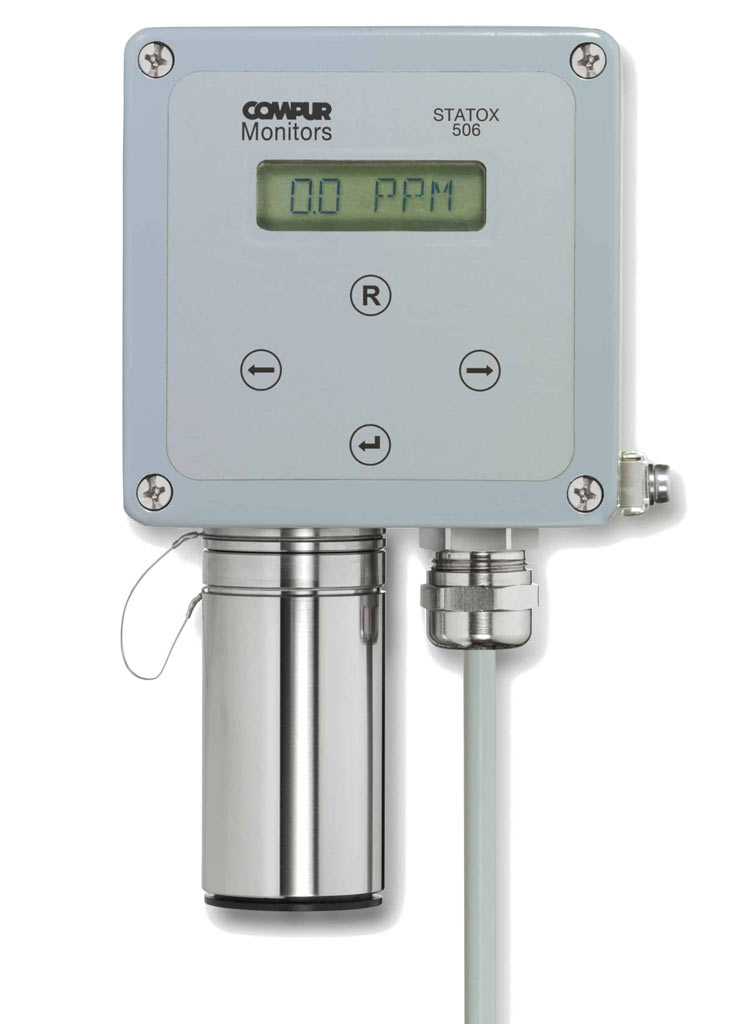Hydrogen cyanide / hydrocyanic acid
Hydrogen cyanide (formula HCN) or prussic acid is a colourless to slightly yellowish liquid when it is pure. It is also flammable, soluble in water and highly volatile. The name hydrocyanic acid goes back to the earlier extraction from the inorganic, pigment “Berlin blue”, which is characterised by a deep blue colour.
Other synonyms for the substance are:
Hydrogen cyanide, hydrocyanic acid, cyclone, formonitrile, formic acid nitrile, Acidum borussicum or prussic acid = Prussian acid (a reference to the first extraction from Prussian (or Berlin) blue).
The odour of hydrogen cyanide is reminiscent of bitter almonds or marzipan, although it should be noted that many people are unable to perceive this odour for genetic reasons.
- Characteristic properties
- Toxic effects
- Symptoms of poisoning
- First aid and antidote for hydrogen cyanide poisoning
- All first aid measures at a glance:
- Occurrence of hydrocyanic acid in nature
- Discovery and production
- Use of hydrogen cyanide
- Use of cyanides
- Handling, storage and transportation
- Historical information on hydrogen cyanide
- How can hydrogen cyanide be detected?
Characteristic properties
In its highly pure form, hydrogen cyanide can be mixed with water and alcohol (ethanol) in any ratio. It has a boiling point of just 26°C. At room temperature, the substance evaporates so quickly that parts of it can freeze due to the evaporation cold.
The bitter almond odour mentioned above normally only occurs at low concentrations and is sometimes described as dull. At higher concentration, prussic acid has more of an unpleasant, almost indescribable odour, which is intensely sharp, pungent and scratchy, irritating to the mucous membranes and leaving a bitter taste in the mouth. However, the smell and taste are only perceived briefly, as even small amounts of the substance are anosmic.
Dissolved in water, hydrogen cyanide is a very weak acid. It will be driven out of its salts – known as cyanides – even by carbonic acid. From a chemical point of view, it represents a borderline between organic and inorganic chemistry, because as a nitrile, a component of formic acid, it belongs to the organic substances.
Hydrogen cyanide is highly flammable and explosive in mixtures with air at a proportion of 5.4 to 46.6 per cent by volume. Since the substance is easily miscible with water, groundwater contamination might occur when extinguishing fires. Therefore, controlled burning will be preferred, provided that other hazards can be excluded.
Toxic effects
Hydrogen cyanide and its salts, the cyanides, are extremely toxic. Just 1 mg to 2 mg per kilogram of body weight is fatal to humans. In addition to direct oral ingestion, poisoning can occur by inhalation or absorption through the skin. This will mainly happen if person exposed is sweating, due to its high water solubility. Hydrogen cyanide has been assigned to water hazard class 3 (= highly hazardous to water) by the Federal Environment Agency.
HCN is so toxic as it will block the binding of oxygen in hemoglobin in the respiratory chain* This blocking is irreversible. As a result of the enzyme deactivation, cell respiration no longer functions, i.e. the cell has no longer access to oxygen. This is known as “internal suffocation”.
Symptoms of poisoning
The first noticeable symptom of cyanide poisoning is a bright red discolouration of the skin. The discolouration is caused by the fact that the inhaled oxygen cannot be absorbed and transported by the cells. This is why the blood in the veins is still enriched with oxygen. This is also the reason why dead people show bright red liver spots on their skin after hydrogen cyanide poisoning, similar to carbon monoxide poisoning. Like the odour of bitter almonds, the liver spots are a sure sign of an unnatural death.
If the hydrogen cyanide concentration in the air is very high, hyperventilation occurs within seconds, followed by respiratory arrest and unconsciousness, and then a cardiac arrest will happaen within a few minutes. In such cases, skin discolouration does not usually occur, due to the speed of the process.
The most important symptoms of hydrogen cyanide poisoning at a glance:
- Shortness of breath
- Smell of bitter almonds when breathing out
- Headaches
- Dizziness
- Vomiting
- Severe cramps
- Fainting
- Pale red skin
The concentration in the air (measured in ppm) has the following effects:
- 300 and more ppm: immediately fatal without first aid
- 2 to 5 ppm: Perception limit due to odour
TRGS 900 – WORKPLACE LIMITS:
0.9 ml/m³
1 mg/m³ - 20 to 40 ppm: mild symptoms after several hours
- 45 to 54 ppm: tolerable between 30 and 60 minutes without immediate or long term damage
- 100 to 200 ppm: fatal after 30 to 60 minutes
- 300 and more ppm: immediately fatal without first aid
First aid and antidote for hydrogen cyanide poisoning
First aiders should first provide themselves with respiratory protection, as even the smallest amounts of hydrogen cyanide escaping from the lungs or clothes of the poisoned person might poison the helper.
Quick action is required in any case. Exposed persons must be removed from the danger zone immediately. Then they must have fresh air, if possible even per ventilation with pure oxygen. If respiratory arrest has already occurred, resuscitation must start immediately. In addition, the patient must receive emergency medical treatment as soon as possible.
Sodium thiosulphate, 4-dimethylaminophenol (4-DMAP), hydroxycobalamin and isoamyl nitrite can be used as antidotes. Intravenously administered sodium thiosulphate facilitates the work of the body’s own enzyme rhodanase, which converts the cyanide ions into rhodanide.
All first aid measures at a glance:
- Respiratory protection for the first aider
- Remove affected persons from the danger area
- Supply fresh air or, better forced respiration with pure oxygen
- Rinse the eyes and skin of the poisoned person with plenty of water
- Remove contaminated clothing
- If HCN has been swallowed, give plenty of water, induce vomiting and administer medical charcoal
- In case of unconsciousness, inject a dose of 5 ml 4-dimethylaminophenol (4-DMAP), the so-called prussic acid kit, into the thigh
- Intravenous administration of sodium thiosulfate, supplemented by other antitoxins
- Rapid transfer of the affected person to medical assistance
Occurrence of hydrocyanic acid in nature
Hydrogen cyanide is not only producedin chemistry, but also occurs in nature. In small quantities in the kernels of stone fruit such as cherries, apricots and peaches, but also in almonds. Here the substance is probably used to protect the seeds from being eaten and as a germination inhibitor. The hydrocyanic acid gas can only escape once the pericarp has rotted, after which the germination process is triggered.
Hydrogen cyanide, a cyanogenic glycoside, is also contained in manioc, a widely consumed foodstuff in the tropics. The root tuber, which is poisonous in its raw state and must first be processed before consumption. It is thoroughly crushed, ground into flour, heated, fermented or rinsed with boiling water.
Other foods that contain hydrocyanic acid in toxicologically relevant quantities are certain varieties of sweet potato, yam, bamboo, sweet sorghum, lima beans and linseed. In particular, unripe bamboo shoots, which are considered a delicacy in Asian countries, contain high levels of hydrocyanic acid. Cases of poisoning in this context are known. The toxin can be separated from the glycosides by intensive boiling.
Other plants with hydrocyanic acid content that are considered poisonous plants are the Brazilian rubber tree and the tropical golden spotted fern. For these, HCN clearly serves as an antifeedant.
Discovery and production
Hydrogen cyanide was discovered in 1782 by the Swedish chemist Carl Wilhelm Scheele (1742-1786). It was formed during a reaction of diluted sulphuric acid with potassium ferrocyanide (II), the so-called red blood lye salt. It can also be produced in a laboratory environment by dripping 50 percent sulphuric acid onto potassium cyanide. The HCN gas then escapes from this mixture and can be liquefied with dry ice cooling. But beware: This form of production is strongly discouraged without suitable protective measures. Hydrogen cyanide is also produced when smoking tobacco and burning certain plastics.
In industry, the Andrussow process is mainly used, in which a mixture of ammonia and methane is partially oxidised with atmospheric oxygen and platinum-rhodium catalysts.
Use of hydrogen cyanide
In industry, hydrocyanic acid is used in many processes, for example in the production of amino acids (especially methionine), cyanuric chloride, prussic acid, sodium cyanide and numerous other derivatives. Large quantities are needed for the production of acetone cyanohydrin and adiponitrile, two intermediate products for plastics. The amino acid methionine is produced on an industrial scale in a multi-stage process. It is used as a supplement to animal feed. Cyanuric chloride is used in the synthesis of pesticides for cereals and sugar cane. In the production of acetone cyanohydrin, hydrogen cyanide is catalytically added to acetone. Adiponitrile is obtained by adding a nickel catalyst to butadiene. This process is also referred to as hydrocyanation.
Hydrogen cyanide is also used in mining, for example to leach gold and silver out of ores in which the precious metals occur only in small quantities. To do this, the gold solution, for example, is reduced with zinc. Another process uses activated carbon made from coconut shells to adsorb the cyanide complex. The gold is then obtained as ash after the organic components have been incinerated.
A third method, which requires modern industrial facilities, is to dissolve the cyanide complex from the activated carbon using a hot sodium cyanide solution. The latter is easier to handle than prussic acid. Unfortunately, this method is very problematic for the environment, as is the rarely used mercury amalgam process. In the gold-producing countries of the Third World, it often causes catastrophic water pollution.
Use of cyanides
The salts obtained from hydrogen cyanide are called cyanides. They are used extensively for hardening steels and for synthesising organic compounds. They also play an important role in the galvanising industry and in the production of pesticides. Cyanides were also used in the coking of coal, meaning that the soils of former coking sites can be contaminated with them today.
Handling, storage and transportation
The handling of hydrogen cyanide requires extreme caution due to its high toxicity. Without special protective measures, people are at risk of death when handling it. In addition, between 30 and 50 per cent of the population are genetically unable to perceive the bitter almond-like smell of hydrogen cyanide.
This genetic deficiency is taken into account, for example, by the Bavarian State Office for Health and Food Safety in aptitude tests for applicants who wish to obtain a licence for pest control or fumigation.
Anhydrous hydrogen cyanide always requires cool storage. Containers containing the substance must only be opened when they are very cold. If this is not taken into account, the low boiling point of hydrogen cyanide creates high pressure in the containers. If opened improperly, this can lead to large quantities escaping suddenly in gaseous form and, in the worst case, even splashing around as a liquid substance.
Pure and anhydrous hydrogen cyanide retains its stability for several months. However, it must be stored properly, as hydrogen cyanide can otherwise polymerise explosively after a certain time, forming azulminic acid, a flaky, brown solid. Polymerisation can be accelerated by traces of heavy metal oxides or alkalis, whereby the surface of the (glass) container is also important. Conversely, the process can be delayed by adding small amounts of mineral or oxalic acid. The fact that the explosive decomposition will take place in the foreseeable future can be recognised by an initial yellowish discolouration of the hydrocyanic acid, which later turns brownish.
Incidentally, hydrogen cyanide may not be stored in schools or school laboratories in Germany due to its very high toxicity.
Hydrogen cyanide is only transported very, very rarely, due to its toxicity. As a rule, the hazardous substance is produced directly at the place of use.
Historical information on hydrogen cyanide
The high toxicity of prussic acid has unfortunately left many dark marks in history. There is evidence of numerous accidents that can be traced back to incorrect handling of the substance. In most cases, the gas escaped into the atmosphere, either in production plants or when used to combat pests such as woodworms, termites and other insects. In other cases, explosions were caused by high concentrations in closed rooms.
During the First World War, hydrogen cyanide was used as a chemical weapon, initially by the French army in 1916 and later by the Germans. However, the substance proved to be not very effective because the gas dissipated too quickly. However, it is added to modern chemical weapons as a ‘mask breaker’ and in this function ensures that the absorption capacity of the gas mask filter is quickly reduced and the actual chemical warfare agent can take effect.
Hydrogen cyanide has been used in some US states until 1999 in some cases of capital punishment in gas chambers. The concentrations used (around 3,200 ppm) were so high that the condemned usually lost consciousness immediately and their hearts stopped beating after a few minutes. Today, hydrogen cyanide is no longer permitted for executions in the USA.
However, the most horrific use of the poison was in the Nazi extermination camps of Auschwitz-Birkenau and Majdanek, where people were murdered in unimaginable numbers with hydrogen cyanide, which escaped from pellets in the gas chambers in gas form. The former name Zyklon B for the biocide has thus become a byword for the Holocaust.
How can hydrogen cyanide be detected?
In today’s industrial production of hydrogen cyanide it is detected in ambient air by sensitive electronic gas detectors such as the mobile tracer for leak detection. For stationary applications Compur offers the Statox product family with various models.

Dr. Hermann Schmidtpott
Managing Director COMPUR MONITORS GmbH & Co. KG
Contact us without obligation
Do you have any questions about our products or would you like a non-binding consultation? We look forward to hearing from you.


